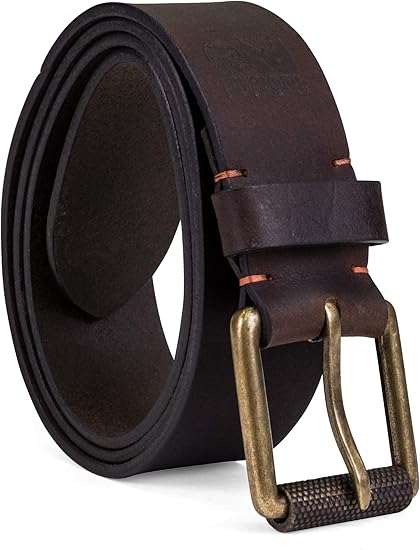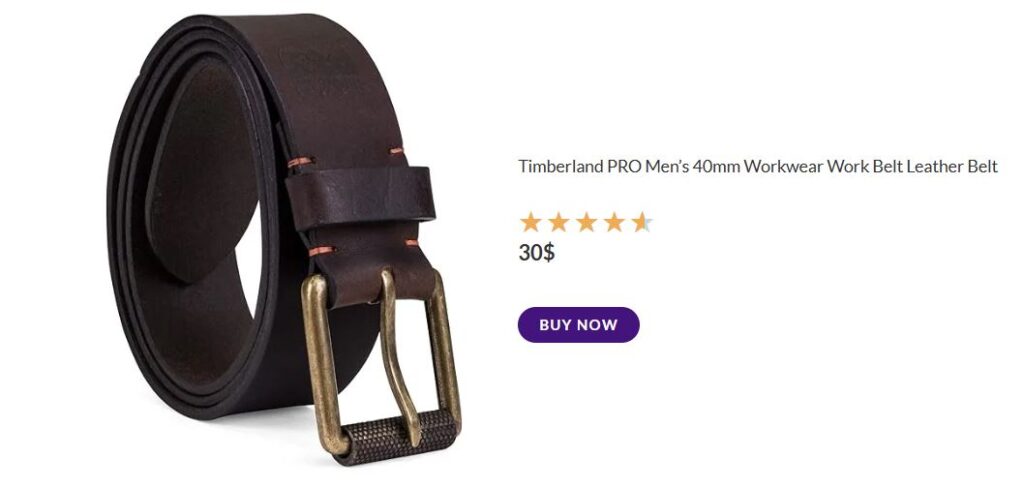Men’s belts are more than just articles of clothing used to hold up pants — they’re essential accessories that can elevate a man’s style. The availability of different design, material and buckle style make the belt a bit challenging to buy. You can be dressing up for an event or simply staying casual, but having the correct belt is definitely going to elevate your appearance a significant few times. Types of Belts for Men, Materials and How to Wear Them In this article we explain everything you need to know about belts for men: from different types and materials, how to wear them or the latest trends — up…medium.com

Timberland PRO Men’s 40mm Workwear Work Belt Leather Belt
30$
Types of Belts for Men
There are so many kinds of belts for men, and all depend on their event dressing and how he decides to dress for it:
1. Casual Belts.
The casual belt is probably wider and can be made out of any material: leather, canvas, or even woven fabric. They can get along with jeans, chinos, or shorts. Typically, the buckles of casual belts are much bigger and less formal than in formal belts.
2. Formal Belts
Formal belts are made of leather and are more narrow in width as compared to informal belts. They go with formal wear and dress pants and most of the times come with sleek designs on the sides, such as simple metallic outline, beneath the buckle. Formal belts mainly come in black and brown.
3. Reversible Belts
Such reversible belts provide a man with two looks wearing only one belt. They come in two shades, though black seems to be the standard on one side and brown is the other standard. This makes them easy to use for men who travel a lot or who would want only one belt for various wardrobes.
4. Braided Belts
Braided belts are the laid-back, relaxed style. These belts, more often leather or fabric, add texture to your outfit and offer a more flexible fit since the buckle can be fastened between any two braids.
5. Fashion Belts
Designer belts are status symbols, but in the case of luxury brands such as Gucci, Louis Vuitton, and Hermes, they are mostly made up of the unique buckles with the brand logo. While being highly costly, they bring out unbeatable craftsmanship and style.
Materials Used in Belts
The material of a belt significantly influences its look, durability, and price. Here are the most common materials used in belts for men:
1. Leather
Leather belts are by far the most popular choice for men, offering both style and durability. The quality of leather can vary, with full-grain leather being the highest quality, followed by top-grain leather, and finally bonded leather, which is the least durable.
Full-grain leather: This is the most durable and high-quality leather type, known for its natural appearance and longevity. Over time, it develops a unique patina, adding character to the belt.
Top-grain leather: Slightly less durable than full-grain leather, top-grain leather has been sanded down to remove imperfections. It’s more uniform but still offers good durability and a polished look.
Bonded leather: Made from leftover leather scraps bonded together with adhesive, bonded leather belts are cheaper but tend to wear out more quickly.
2. Suede
Soft suede belts can easily pass for a casual look and work very well with jeans, pairing well to create a more rugged or stylish look.
3. Canvas
Canvas belts are light in weight and are usually matched with casual, outdoor, or sporty clothing. These belts are strong yet flexible, so they go very well with jeans or casual pants. Some canvas belts also come with D-ring buckles rather than regular metal buckles.
4. Synthetic Materials
Budget-conscious buyers can purchase belts made from synthetic materials that imitate the looks of leather at a lower cost. It just doesn’t have the same durability as a leather belt, though.
How to Choose the Right Belt
Things to consider when choosing a belt:
1. Belt Width
Width of the belt is also an essential thing to consider. As a general rule:
The formal belts should be 1.25 inches wide.
Casual belts can be wider, usually between 1.5 and 1.75 inches.
Narrow belts are normally more formal than wide belts. Wide belts go well with casual wear.
2. Matching to Shoes
One simple rule of dressing is to match the belt with your shoes, especially when wearing formal clothes. Should you be putting on black shoes, pick up a black belt. Likewise, brown belts for brown shoes. The closer the color and texture are, the better it will look.
3. Buckle Type
There are several types of buckles and each one style remains unique
Frame buckles: The most common type, typically found on formal belts. Plate buckles are larger and typically carry an ornamental design, which makes them relatively good for casual wear. Buckles with D-ring: These are normally employed in fabric belts for a laidback and informal appearance. Box frame buckles: These belts do not have holes. Instead, the buckle holds the belt in place using friction.
4. Fit
A belt should fit well, meaning the end should stick out a few inches past the buckle. Most belts have five holes, and you should usually use the third one to fasten the belt. If you do not know what size you wear, select a belt that is 2-3 inches longer than your waist size.
Trends in Men’s Belts (2024 Update)
The latest trends in men’s belts focus on both functionality and fashion:
1. Sustainable Belts
More people know about sustainability now, so many brands are selling eco-friendly belts. These belts are made from recycled materials or plant-based leather options like cork and pineapple leather. They look good and help the environment.
2. Strong Buckles
In 2024, belts with big, eye-catching buckles are popular. These belts have large buckles or special designs with logos or fancy details, and they work as both accessories and interesting topics to talk about.
3. Braided and Woven Designs
Braided belts can be worn nowadays, especially for casual wear. Woven belts made of stretchable material allow one to wear them comfortably as well as in style and give a good fit.
4. Simple Designs
Simplicity appeals most to men. Thus, belts made of materials with simple lines and little ornamentation are the favorite ones, and their colors often are black, brown, or tan. These belts can be worn in both casual and formal settings.
Belt Care and Maintenance
A belt should be cared for if it is to last a long time
1. Leather Belt Care
Use a leather conditioner every few months to stop cracks and keep the leather soft.
You should keep leather belts dry to prevent mold damage. If your belt gets wet, let it dry in the air on its own.
Store properly: Store leather belts by hanging them or rolling them loosely to avoid creases.
2. Suede and Fabric
Belt Care Clean carefully: Just use a suede brush to clean up suede belts. Dirt can be easily removed with this. Mild soap and water should work with fabric belts.
Keep away from heat: Materials will flex or discolor at high temperatures, so belts should avoid direct sunlight.
Conclusion
Men’s belts do a little more than just suspender trousers; it makes the overall appearance nice and complete.You also understand the different kinds of belts and materials, which help you decide which one to use on an occasion, making sure you will have the right style. With both formal leather and casual braided ones, choosing the right belt just enhances your wardrobe and builds up confidence. Always look for a belt that fits the occasion, is fitted properly, and blends in with your shoes.
While purchasing belts, think beyond their style. Think about the quality and length of time they will last when getting the best value for your money. Given the increase in trends that talk about ecology and striking styles, this is the best moment to create a collection of versatile belts.

